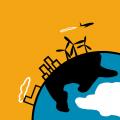
This Guide for Educators was developed by the MIT Environmental Solutions Initiative as an extension of our TILclimate (Today I Learned: Climate) podcast, to make it easier for you to teach climate change, earth science, and energy topics in the classroom. It is an extension of the TILclimate episode "TIL about carbon offsets."
Browse all TILclimate guides for educators.
Description
Countries, companies and even individuals can pay for carbon offsets to reach “carbon neutral” or “net zero” targets. Students investigate carbon dioxide distribution, what carbon offsets are, the history of the Kyoto Protocol, and how forest health interacts with carbon offset claims.
SWBAT
- Explain that carbon dioxide is emitted in some places more than others but distributes throughout the atmosphere.
- Describe the idea of a carbon offset.
- Understand the basics of the Kyoto Protocol.
- Analyze carbon offset claims of companies and organizations.
Skills
- Media literacy
- Discussion
- Map reading
Standards:
- HS-ESS3-6 Use a computational representation to illustrate the relationships among Earth systems and how those relationships are being modified due to human activity.
- HS-ETS1-3 Evaluate a solution to a complex real-world problem
- RST.9-10.8 Assess the extent to which the reasoning and evidence in a text support the author’s claim.
Disciplinary core ideas:
-
ESS2.D Weather and Climate
-
ESS3.A Natural Resources
-
ESS3.C Human Impacts on Earth Systems
-
ESS3.D Global Climate Change
What is included in this Educator Guide
- How to use TILclimate Educator Guides (Download)
- Full Educator Guide (Download)
- Includes both Teacher and Student pages
- Includes both Teacher and Student pages
- Teacher pages (Download)
- Includes materials, discussion questions, background resources, and adaptation suggestions for science, social science, and ELA teachers
- Includes materials, discussion questions, background resources, and adaptation suggestions for science, social science, and ELA teachers
- Student pages (Download)
- Video Observation: Carbon Dioxide Distribution
- Reading & Discussion: Kyoto Protocol
- Communication Investigation: Carbon Offsets
- Data Investigation: Forests and Carbon
Listen to the episode
Browse all TILclimate guides for educators


